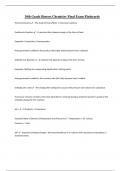Exam (elaborations)
10th Grade Honors Chemistry Final Exam Flashcards
- Course
- Institution
10th Grade Honors Chemistry Final Exam Flashcards Thermochemistry ️The study of heat effects in chemical reactions. Exothermic Reaction ️A reaction that releases energy in the form of heat. Examples: Combustion, freezing water. Heat generated is added to the product side (right side) be...
[Show more]



